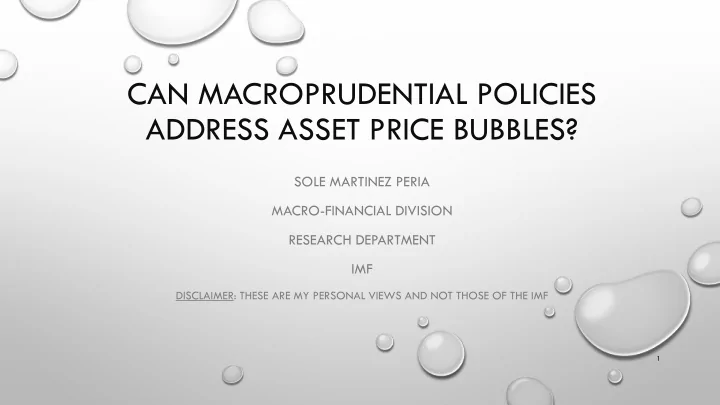

CAN MACROPRUDENTIAL POLICIES ADDRESS ASSET PRICE BUBBLES? SOLE MARTINEZ PERIA MACRO-FINANCIAL DIVISION RESEARCH DEPARTMENT IMF DISCLAIMER: THESE ARE MY PERSONAL VIEWS AND NOT THOSE OF THE IMF 1
BUBBLES ARE COMMON… 2
… AND EVENTUALLY BURST…IS THIS BAD? … 3
GOAL OF THIS PANEL IS TO PONDER THE FOLLOWING QUESTION: CAN MACROPRUDENTIAL POLICIES BE USED TO ADDRESS BUBBLES? BUT PERHAPS MORE RELEVANT TO ASK: SHOULD MACROPRUDENTIAL POLICIES BE USED? WHEN? HOW? 4
OUTLINE 1. Objective of macroprudential policies 2. When to use macroprudential policies to deal with bubbles? 3. Which bubbles should be tackled with macroprudential policies? 4. Evidence of effectiveness of macroprudential policies 5. Challenges of macroprudential policies 5
MACROPRUDENTIAL POLICIES OBJECTIVES Ultimate goal: limit systemic risk —risk of disruptions to the provision of financial services due to impairment of all or parts of the financial system (IMF, 2013). Intermediate objectives: (1) Increase the resilience of the financial system to aggregate shocks. (2) Contain the build-up of systemic vulnerabilities over time. (3) Control structural vulnerabilities within the financial system. 6
BUBBLES AND FINANCIAL STABILITY • Bubbles with limited leverage and bank involvement tend to deflate without major economic disruptions (e.g., dot-com bubble). • Bubbles are a concern when financed through credit by leveraged institutions. 1. The health of the financial system can be compromised. 2. Supply of credit can contract with negative consequences for real economic activity. CASE FOR MACROPRUDENTIAL POLICIES 7
BUBBLES AND FINANCIAL STABILITY 8 From Crowe et al. (2013)
REAL-ESTATE BOOMS AND MACROPRUDENTIAL POLICIES • Involvement of financial institutions and use of leverage more likely for real estate booms relative to other assets (tulips, stocks, crypto assets, etc.). • Also, real estate is main source of wealth for households. • Twin credit and real estate booms are dangerous: – Joint credit and asset price deviations from long-term trends are leading indicators of banking distress (Borio and Lowe, 2002; Borio and Drehmann, 2009). – Twin booms have been accompanied by either a financial crisis or poor economic performance in 90 percent of the cases (Crowe et al, 2011). CASE FOR MACROPRUDENTIAL POLICIES 9
MACROPRUDENTIAL POLICY TOOLS 10 IMF, 2013
EVIDENCE ON THE EFFECTIVENESS OF MACROPRUDENTIAL POLICIES ON REAL ESTATE PRICES • Targeted policies (e.g., limits on LTVs and DSTI) have an impact on house prices. – Ahuja and N abar (2011), Duca et al. (2011), Igan and Kang (2011), Crowe et al. (2013), Akinci and Olmstead-Rumsey (2017) • Capital and liquidity measures also affect house prices. – Vandenbussche et al. (2015) • Other measures (such as housing-related taxes) can help contain house price appreciations. – Kuttner and Shim (2013) 11
CHALLENGES IN MACROPRUDENTIAL POLICIES • Calibrating policies When to implement policies? When to tighten, by how much? When to relax, by how much? • Avoiding leakages/circumvention • Governance and coordination 12
TAKEAWAYS What matters is not necessarily the bubble itself but how it is funded. 1. • Busts tend to be more costly when bubbles are financed through credit. 2. Debt financed bubbles more likely for real estate assets. 3. Macroprudential policies can be used to address real estate booms. 4. But there are challenges to the use of macroprudential policies. 13
Recommend
More recommend